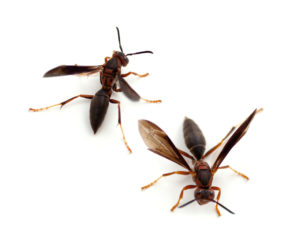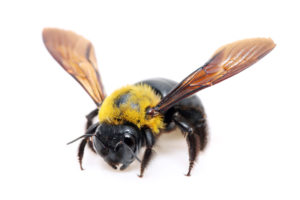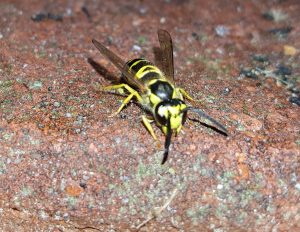Hornets, Bees, and Wasps…What’s the buzz?

Here we are on the brink of summertime in Georgia, and guess who’s back?? Wasps and bees!! That’s right, buzzing and pollinating and well, stinging their way into your life, these little insects can be both a help and a hindrance. Let’s explore the world of our buzzy little friends, or some might say…foes.
Who exactly is the lowly bee? Well, the bee is an amazing little creature. 1 out of every 3 bites of food we eat is pollinated by a bee. That’s an amazing fact and a good reason to protect the hives. How do we identify the little insects? Bees are typically hairier than wasps and do not have a thin midsection. Even though they will protect their hive, they are not particularly aggressive.
In Georgia, we have a number of wasp species including the red and brown paper wasp, the striped guinea wasp, and other mud-daubers and assorted solitary wasps. We also have hornets such as yellow jackets, bald-faced hornets, and the very large European hornet. All of these guys sting! There are actually over 100,000 different kinds of wasps, bees, and hornets. A wasp looks somewhat like a bee in that they have hardly any hair, are brightly colored, and sport a narrow waistline! But wasps can be identified by their legs hanging down flight methods. Of greater concern, wasps and hornets are much more aggressive and likely to sting than a bee.
Why do we see so many bees and wasps around our pool and other water areas? Just like us, bees and wasps need the water to cool themselves and keep their bodies functioning. Wasps and bees send out foragers to gather water for the nest. These workers collect water and take it back to the hives/nests. The collection actually happens year-round but is needed more often in the summer due to the heat. Listen to this crazy scenario: the foraging insects bring water back to the nest/hive and the colony workers spread the water over the cells containing the larvae/eggs. Other workers inside the hive or nest will fan their wings to produce a cooling effect for the growing babies! Homemade air-conditioning. So wasps and bees need water, it’s true.
But does this mean your outdoor recreation area has to be shared with stinging insects?
The majority of the time, a single sting is not a cause for concern. Dangerous situations tend to occur when the stinging insect is protecting its home. In this case, a person could be stung multiple times by multiple bees/wasps. Remember, the bee is generally not aggressive unless protecting their home. The wasp and hornet, on the other hand, can sting multiple times and is considered aggressive in comparison to the bee. They may sting you just for the fun of it! Most people experience some pain, redness, and swelling after a sting from a bee or wasp. Some have a more serious reaction and swell for several days. Unfortunately, there are individuals who have a much more serious reaction called anaphylactic shock. When the immune system reacts incorrectly to a sting or allergen, a person can have difficulty breathing, tightness in the chest, have a severe drop in blood pressure, and even become unconscious and die. Obviously, this is an extreme case and not the norm. Still, this is reason enough to keep your family safe from harm when you are hanging out around the family pool or other outdoor area.

This year, our family invested in a pool. 2020 can’t go anywhere anyway, so we thought…home is where the fun happens. But now we have a problem. Word got around to the neighborhood flying insect society, and tada…the guests have arrived. How to keep the pool area safe from unwanted visitors is the next question to be answered. Since we have established that bees and wasps need water, the first step is to secure any water feature as much as possible. If you have a pool, a cover is an expensive but worthwhile investment. Not only does the cover keep the stinging insects from deciding your backyard is “the watering hole”, but it also keeps the pool clean and your small children safe. Next, you can supply your neighboring, buzzy buddies a different option. Fill a birdbath or even a bucket with water that you keep clean and filled. This gives them a viable option to your pool. The smell is a big deal. Empty the trash and keep food cleared away from the gathering areas. Wasps are attracted to nectar from flowers, so bare that in mind with close plantings. On the flip side, there are certain plants that actually repel wasps and bees. Lemongrass, eucalyptus, and mint are unattractive to flying insects. And how about this, dryer sheets are a repellant as well. You have to replace them often, but the smell sends the little bugs far away. If all else fails, you can spray the insects with a soap and water solution to send the foragers packing. Lastly, wasp traps are a possible deterrent. These homemade contraptions place sugar water or sweet syrup on either cardboard or a wood product. This attracts the wasps and causes them to get stuck on the sticky liquid. If the forager can’t get back to tell the colony where the water is, then the colony won’t keep coming back for visits. Remember, bees and wasps are more attracted to calm water as they need to light on the surface. Water turbulence discourages them. Water features or splashing and playing will send the insects packing.

So there you have it, the buzz on bees and wasps around your pool and home fun zone. There are some great ways to minimize the risk of stings, but as always there are times when an expert is in order. Nests can be extremely dangerous to remove even if you aren’t highly allergic to stings. Canton Termite and Pest Control can be a big help plus keep you and your family safe from painful stings. If you have a wasp or bee problem, give us a call at 770-479-1598. We are here to help your home stay pest-free and keep your play area a sting-free zone!
By: Robin
